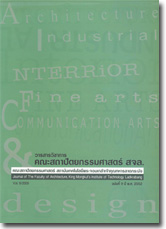APPLICATIONS OF STATED PREFERENCE TECHNIQUES FOR PUBLIC-PRIVATE PARTNERSHIP PROJECTS IN DEVELOPING COUNTRIES
Main Article Content
บทคัดย่อ
Abstract
Discrete Choice Modelling (DCM), especially Stated Preference (SP) techniques, have been used to evaluate the effects of relevant attributes (attribute valuation) of a system on individuals’ responses, calculate the value of money, and provide forecasts of changes in travel demand. SP techniques are especially useful for studying non-existing market situations, such as improving public transport services, building new mass transit line, building new motorway/tollways, and implementing road pricing. SP techniques have been widely used for over three decades, while Public-Private Partnership (PPP) projects have been initially introduced the private finance initiative (PFI) in the United Kingdom for two decades. The objective of this paper is to introduce SP techniques, and its applications in developing countries, particularly for PPP projects. In order to apply effectively SP techniques for Public-Private Partnership projects in developing countries, and to consider some key issues of SP techniques, such as SP experiment design, measurement of attributes, data collection method, respondents’ understanding of new scenarios, and some key issues of Public-Private Partnership (PPP) projects in developing countries, such as unclear governing framework, fragmented authorities, time consuming procedure, insufficient institutional support, and lack of rules and capacity with respect to risk allocation.
Keywords: Discrete Choice Modelling (DCM), Stated Preference (SP) techniques Public-Private Partnership (PPP), Developing Country
Article Details
This work is licensed under a Creative Commons Attribution-NonCommercial-ShareAlike 4.0 International License.
Copyright Transfer Statement
The copyright of this article is transferred to Journal of The Faculty of Architecture King Mongkut's Institute of Technology Ladkrabang with effect if and when the article is accepted for publication. The copyright transfer covers the exclusive right to reproduce and distribute the article, including reprints, translations, photographic reproductions, electronic form (offline, online) or any other reproductions of similar nature.
The author warrants that this contribution is original and that he/she has full power to make this grant. The author signs for and accepts responsibility for releasing this material on behalf of any and all co-authors.


